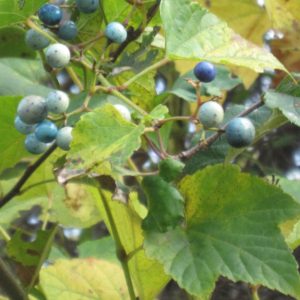Click an image to help identify what you see outside, then continue to the removal page for more photos.
Long Island is home to both native (sometimes aggressive) and non-native (invasive) vines. For instance, our native poison ivy, considered noxious aggressive by many, is so only for people who suffer with rashes after touching the leaf, vine or root. Animals don’t have the same reaction, and in fact, the berries are a good food source for them. Poison ivy is listed here among the non-native invasive plants because it often grows alongside the truly invasive plants such as Oriental bittersweet, English ivy, porcelain berry, Japanese honeysuckle, Asian wisteria, winter creeper, and kudzu, and could easily be touched or brushed against by someone attempting to remove one of these non-native species.
Another native vine is New England grape, which can be easily confused with the non-native invasive, porcelain berry. While the berries of both species are a feast for birds, both vine species can bring down limbs and eventually kill trees by their dense leaf cover over the canopy, shading sunlight from the host tree. Porcelain berry vines have become pervasive on Long Island of late and should be removed before they bloom in July. The best time for severing New England grape vines from trees is late fall through early spring when other plants, which could impede access, are dormant. Click Vine Removal for details.
Soon after removing vine roots, cover the ground with mulch (a thick layer of leaves) or replace them with native, shade loving plants (plugs or seeds) such as white wood aster Eurybia divericata, and then mulch.
White wood aster is a hardy, fast growing, beautiful shade loving flowering perennial that also serves as a weed suppressant. It self-seeds, blooms through September, is a source of nectar and pollen for pollinators, and native birds feast on the seeds. Click Native Plants in Recent Posts.








